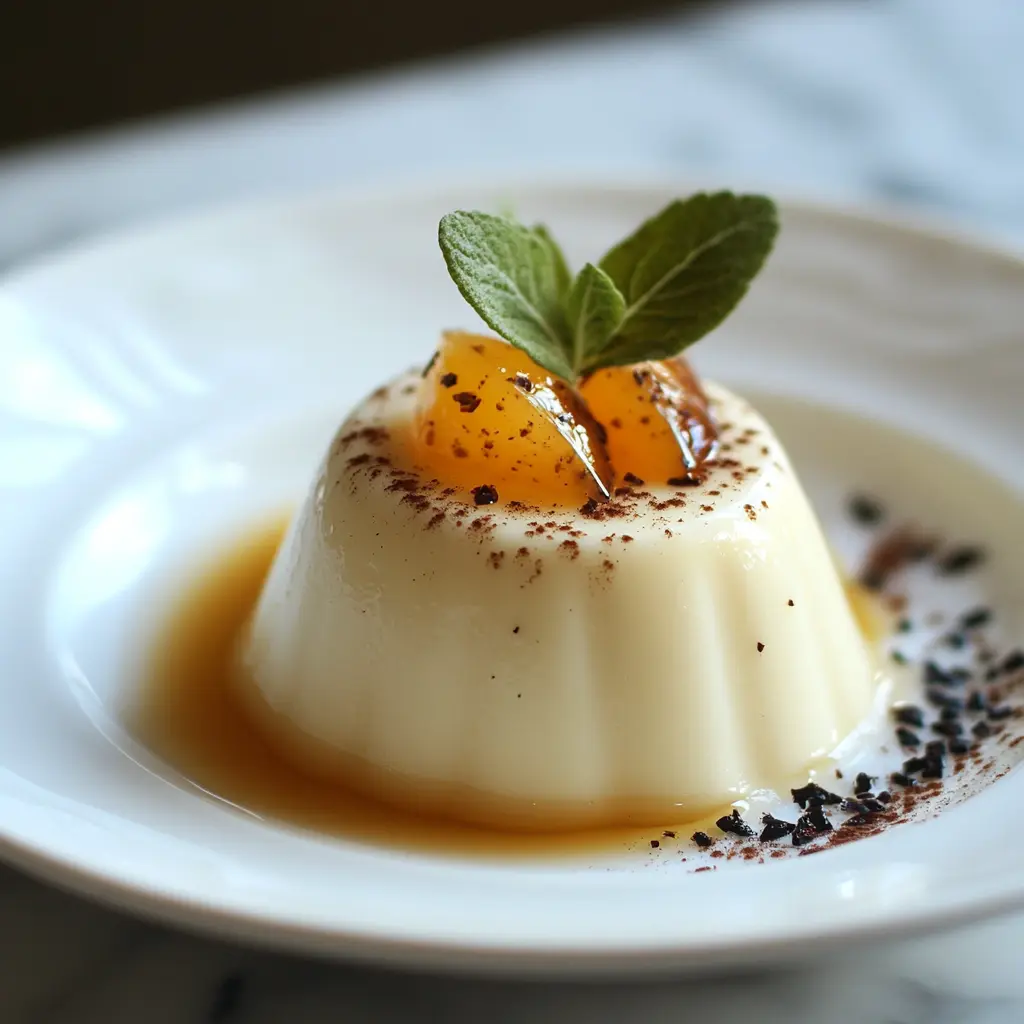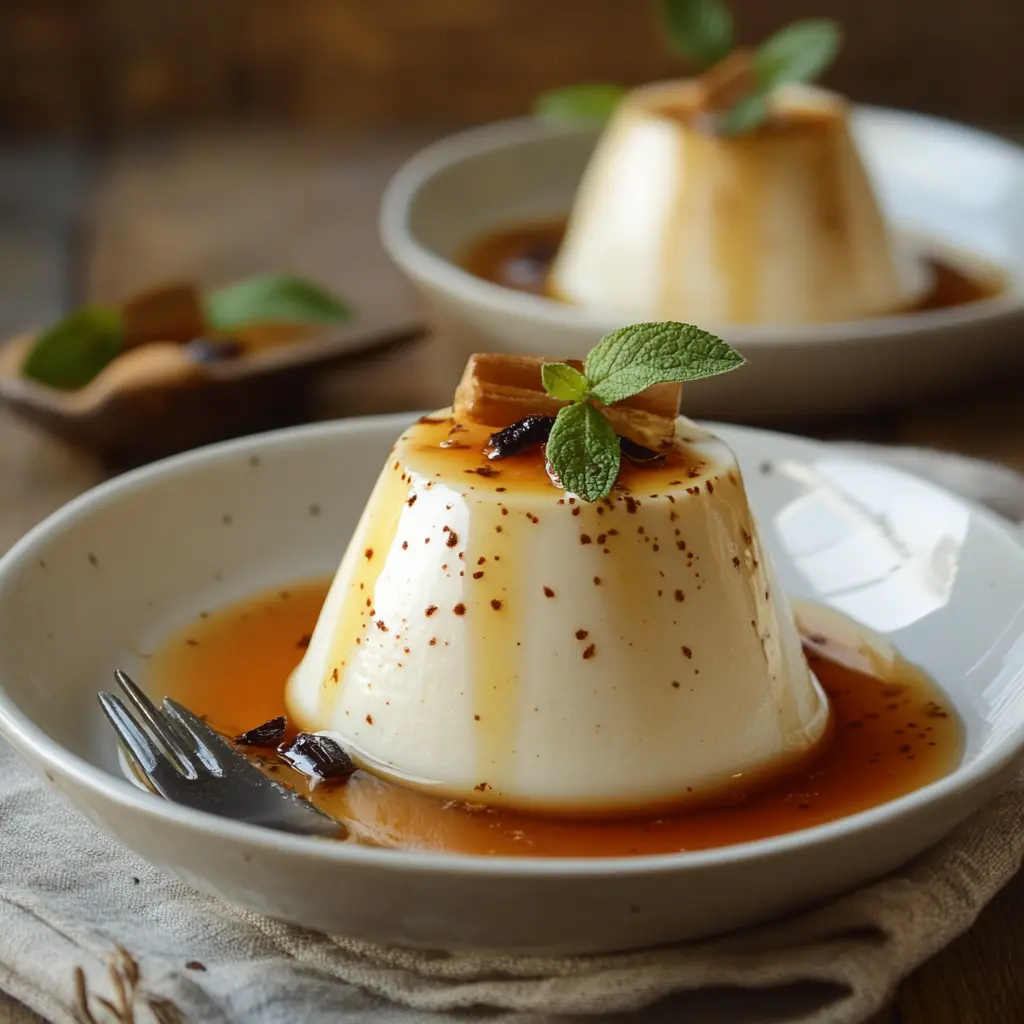Introduction to Honey Vanilla Panna Cotta
Overview of Panna Cotta
Panna cotta, which translates to “cooked cream” in Italian, is a beloved dessert with roots in Northern Italy. This creamy delicacy is known for its silky texture and ability to take on various flavors, making it a versatile treat.
Traditionally made with simple ingredients like cream, sugar, and gelatin, panna cotta has a light yet indulgent quality. The dessert is chilled until it sets, creating a smooth, custard-like consistency without requiring eggs or baking. It’s often served with fruits, sauces, or other creative garnishes that enhance its flavors.
Panna cotta’s popularity stems from its simplicity and elegance. Whether presented at upscale restaurants or prepared at home, it embodies the heart of Italian cuisine—quality ingredients and straightforward preparation. This dessert is perfect for any occasion, from casual dinners to festive celebrations.
The Appeal of Honey and Vanilla Flavors
The combination of honey and vanilla elevates panna cotta to new heights. Honey brings a natural sweetness, offering floral and earthy undertones that sugar cannot replicate. Its complex flavor profile adds depth while maintaining balance.
Vanilla, with its rich and aromatic essence, enhances the dessert’s creamy base. Whether using pure vanilla extract or fresh vanilla beans, its warmth complements the creaminess and highlights the honey’s subtle sweetness.
Together, honey and vanilla transform panna cotta into a harmonious blend of flavors. This pairing creates a dessert that feels indulgent yet light, satisfying a variety of palates. Their natural appeal makes this version of panna cotta a timeless and crowd-pleasing favorite.
Ingredients and Equipment
Essential Ingredients for Honey Vanilla Panna Cotta
To create a truly exceptional honey vanilla panna cotta, the right balance of ingredients is crucial. Each element plays a vital role in crafting the perfect dessert.
Cream is the foundation of panna cotta’s rich, velvety texture. It provides the necessary smoothness and creaminess, giving the dessert its signature melt-in-your-mouth experience. Heavy cream or double cream is recommended for the best results.
Milk complements the cream by adding a lighter, more delicate touch. A full-fat milk variety enhances richness, but skim milk can be used for a lighter version without sacrificing too much creaminess.
Honey serves as the sweetener for this dessert, adding natural sweetness and complexity. Different types of honey—such as clover, wildflower, or acacia—bring subtle variations in flavor. Opting for a high-quality, raw honey yields the most pronounced taste.
Vanilla, whether in extract form or from a fresh vanilla bean, is essential for adding warmth and depth. The vanilla bean offers a more intense, aromatic flavor, while extract is a convenient and slightly milder alternative.
Gelatin is the key ingredient that helps panna cotta set into its silky, custard-like consistency. If gelatin is not preferred, agar-agar or a combination of cornstarch and agar can be used as vegan alternatives.
Optional additions, such as yogurt or buttermilk, can provide an extra layer of tang, enhancing the overall flavor complexity.
Selecting Quality Ingredients
For the best results, start with fresh dairy products. Fresh cream and milk ensure the smooth, creamy texture that defines panna cotta. Look for high-quality, full-fat dairy for a richer experience.
Choosing high-quality honey is equally important. Raw, unfiltered honey offers a more vibrant flavor and beneficial properties. Be sure to select honey that complements the dessert’s delicate flavors.
When it comes to vanilla, go for pure vanilla extract or fresh vanilla beans. While vanilla extract is more accessible, a scraped vanilla bean offers a more robust and authentic flavor profile that elevates the panna cotta.
Necessary Equipment
To prepare your honey vanilla panna cotta, you’ll need the right tools. A saucepan is essential for heating the cream and milk mixture.
Mixing utensils like a whisk or spoon will help combine ingredients evenly.
Ramekins or molds are used to shape the panna cotta before chilling. Small ceramic ramekins are a popular choice, but silicone molds can provide easy release when unmolding.
Finally, measuring tools such as cups and spoons ensure accuracy, especially when dealing with ingredients like gelatin or vanilla.
Step-by-Step Preparation Guide
Preparing the Gelatin Mixture
The first step in making panna cotta is preparing the gelatin. This process, known as blooming, involves hydrating the gelatin in cold water. Simply sprinkle the gelatin over a small amount of cold water and let it sit for 5-10 minutes. This softens the gelatin, allowing it to dissolve smoothly in the warm mixture later.
If you prefer a vegetarian or vegan alternative, agar-agar is an excellent substitute. This plant-based setting agent requires boiling to activate, so be sure to follow the specific instructions. Agar-agar sets the panna cotta firmer than gelatin, so adjustments to the recipe may be necessary for the perfect texture.
Combining Dairy and Flavorings
Next, it’s time to combine the cream and milk. Pour them into a saucepan and heat them over medium-low heat. Stir frequently to prevent the mixture from scorching. The goal is to warm the cream and milk without bringing them to a boil—this ensures a smooth, creamy texture.
Once the dairy is heated, add the honey and stir until fully dissolved. Honey adds a delicate sweetness, so be sure to adjust the amount according to your taste. Next, incorporate the vanilla extract or vanilla beans. If using a vanilla bean, scrape the seeds and add them directly into the cream mixture, allowing the flavors to infuse as it heats.
To achieve the right temperature, ensure the cream is just warm enough to dissolve the gelatin without simmering. Keep the mixture between 140-160°F (60-70°C) for optimal results.
Integrating Gelatin into the Mixture
Once the gelatin has bloomed, add it to the warm cream mixture. Stir gently but thoroughly to ensure the gelatin dissolves completely, preventing any lumps. If necessary, warm the mixture slightly to help the gelatin dissolve, but do not let it boil.
Take care to avoid over-stirring, as this could cause air bubbles, which will affect the texture of the panna cotta. A smooth, silky mixture is the key to a successful dessert.
Pouring and Setting the Panna Cotta
Now that the panna cotta mixture is ready, it’s time to pour it into molds or ramekins. To prevent any spillage or mess, use a ladle or small measuring cup to carefully pour the mixture into each mold. Ensure each mold is filled evenly.
For smooth, pristine surfaces, pour slowly and steadily, avoiding any drips. Once poured, refrigerate the panna cotta for at least 4 hours, or until it is set. To prevent accidental contact with the surface while it sets, cover the molds loosely with plastic wrap.
Unmolding and Serving
After the panna cotta has set completely, it’s time to unmold. To make this process easy, briefly dip the outside of the molds into warm water to loosen the edges. Gently run a knife around the sides to ensure a clean release.
Turn the mold upside down onto a plate and give it a gentle shake. The panna cotta should slide out effortlessly. For an added touch, serve with fresh fruit, a drizzle of honey, or a sprinkling of chopped nuts. This dessert shines in its simplicity, and these small garnishes complement its delicate flavor beautifully.
Variations and Accompaniments
Flavor Variations
One of the best features of honey vanilla panna cotta is its versatility. By incorporating different extracts, you can create a wide array of flavor profiles. Try adding almond extract for a nutty twist or coconut extract for a tropical flair. A hint of citrus, like lemon or orange extract, can provide a refreshing contrast to the creamy base.
Alternative sweeteners can also be used to adjust the flavor and make the dessert more tailored to specific preferences. Maple syrup offers a rich, earthy sweetness that complements the vanilla. Agave nectar or stevia are great options for those seeking a lower glycemic index sweetener while still achieving the desired sweetness.
For a more complex flavor, consider infusing herbs or spices into the panna cotta mixture. Lavender, rosemary, or basil can add a fragrant layer of flavor, while spices like cinnamon, cardamom, or nutmeg can warm up the profile. Simply steep the herbs or spices in the cream and milk mixture, then strain them out before adding the gelatin.
Seasonal Fruit Toppings
Adding fresh seasonal fruits is a perfect way to enhance your honey vanilla panna cotta. Berries, such as strawberries, raspberries, and blueberries, bring a pop of color and natural tartness that balances the rich, creamy base. Stone fruits like peaches, nectarines, and plums also make great pairings, offering juiciness and sweetness. Citrus fruits, like oranges or grapefruits, add a refreshing tang that cuts through the richness.
To elevate your fruit topping, prepare fruit compotes. Simmer the fruit with a little honey or sugar to create a syrupy sauce that can be spooned over the panna cotta. This not only enhances the flavor but also adds a beautiful, glossy finish.
When pairing fruits with honey vanilla panna cotta, aim for a balance of sweetness and acidity. The fresh fruits should complement the smooth, sweet creaminess of the panna cotta without overwhelming it.
Sauces and Garnishes
Sauces and garnishes are the finishing touches that elevate your panna cotta from delicious to extraordinary. Caramel and chocolate sauces are rich, decadent options that pair wonderfully with the smooth texture of the panna cotta. You can either drizzle them on top or serve them on the side for dipping.
Nut brittle or candied nuts add a delightful crunch and contrast the creamy dessert. Almonds, pistachios, or hazelnuts work beautifully when caramelized or candied. A sprinkle of these will add both texture and flavor.
For an elegant and visually appealing garnish, consider edible flowers like violets, pansies, or nasturtiums. Fresh herbs, such as mint or basil, also make great garnishes. They add a pop of green color and a fresh aroma that complements the dessert’s flavors.
Frequently Asked Questions (FAQs)
What is the origin of panna cotta?
Panna cotta, meaning “cooked cream” in Italian, originates from the Piedmont region in Northern Italy. Its humble beginnings date back to the 18th century, when it was a rustic dish made with simple ingredients like cream, sugar, and gelatin. Over time, panna cotta spread throughout Italy and beyond, gaining popularity for its creamy texture and versatility.
Regional variations of panna cotta exist, with different areas adding their own twist. In some regions, it’s flavored with coffee, chocolate, or citrus, while others incorporate herbs and spices for added complexity. Despite its varied renditions, the core elements—cream, sweetness, and gelatin—remain consistent across all versions.
Can I make panna cotta without gelatin?
Yes, you can make panna cotta without gelatin by using vegetarian alternatives like agar-agar. Agar-agar, derived from seaweed, sets the dessert firmer than gelatin, so adjust the recipe accordingly to ensure the right texture. Another option is using arrowroot powder or pectin for a softer set. When substituting these agents, be sure to follow specific instructions, as they each have unique properties and require different preparation methods.
How far in advance can I prepare panna cotta?
Panna cotta is best prepared ahead of time, as it requires chilling for at least 4 hours to set properly. You can make it a day or two in advance for convenience. After it has set, store it covered in the refrigerator. Be mindful not to freeze the panna cotta, as freezing can affect its smooth texture. To maintain its flavor and consistency, keep the panna cotta refrigerated and serve it within 2-3 days.
Why didn’t my panna cotta set properly?
If your panna cotta didn’t set, there are a few common mistakes that could have caused the issue. One possibility is not blooming the gelatin properly. If the gelatin wasn’t allowed to hydrate in cold water first, it may not dissolve correctly in the warm mixture. Another reason could be that the cream mixture was heated too high, preventing the gelatin from setting properly. To troubleshoot, make sure the gelatin is dissolved completely and the mixture is heated gently. If it still doesn’t set, you may need to adjust the gelatin amount or switch to an alternative setting agent.
Can I freeze panna cotta?
Freezing panna cotta is not recommended, as it can affect its texture, making it grainy or watery when thawed. The creamy consistency may break down upon freezing and thawing. However, if you must freeze it, ensure it is well-wrapped in plastic wrap or stored in an airtight container to prevent freezer burn. To thaw, place the panna cotta in the refrigerator overnight and serve it chilled.
What are some dairy-free alternatives for panna cotta?
To make dairy-free panna cotta, simply substitute plant-based milks such as coconut milk, almond milk, or oat milk for the dairy cream and milk. Coconut cream or cashew cream are excellent choices for achieving a rich, creamy texture. When making this substitution, you may need to adjust the amount of sweetener to balance the flavor. For the setting agent, you can use agar-agar, which is a great vegan alternative to gelatin. Be sure to follow proper instructions for agar-agar to ensure the panna cotta sets properly.
How can I reduce the sweetness of panna cotta?
To reduce the sweetness of your panna cotta, adjust the honey quantity. Start with a smaller amount and taste as you go, increasing it if needed. You can also balance the sweetness by using toppings that offer a tart or savory contrast, such as fresh berries, citrus slices, or a light fruit compote. This allows the creamy base to remain the focus while controlling the level of sweetness.
Is it possible to make panna cotta vegan?
Yes, panna cotta can be made vegan by using plant-based ingredients. Replace the dairy cream and milk with coconut cream, almond milk, or another plant-based option. For the sweetener, use maple syrup or agave nectar instead of honey. Most importantly, substitute gelatin with agar-agar or another vegan setting agent. Agar-agar, when used correctly, creates a firm set and provides a slightly different texture, so be sure to follow the instructions for the appropriate amount and preparation method.
Conclusion: Summarizing the Delight of Honey Vanilla Panna Cotta
Honey vanilla panna cotta is a dessert that balances simplicity with sophistication. It’s rich, creamy, and incredibly versatile. Whether you stick to the classic recipe or experiment with variations, the key lies in using quality ingredients and mastering the technique. From the subtle sweetness of honey to the warmth of vanilla, this dessert never fails to impress.
Remember the essential steps—blooming gelatin, heating the dairy, and carefully integrating the flavors—ensure that your panna cotta sets perfectly every time. With endless possibilities for customization, such as fruit toppings or spice infusions, this dessert can be tailored to suit any occasion. Whether you’re serving it at a dinner party or enjoying it with loved ones, honey vanilla panna cotta offers a memorable, indulgent experience. Experiment, enjoy, and share this timeless treat with those around you.




